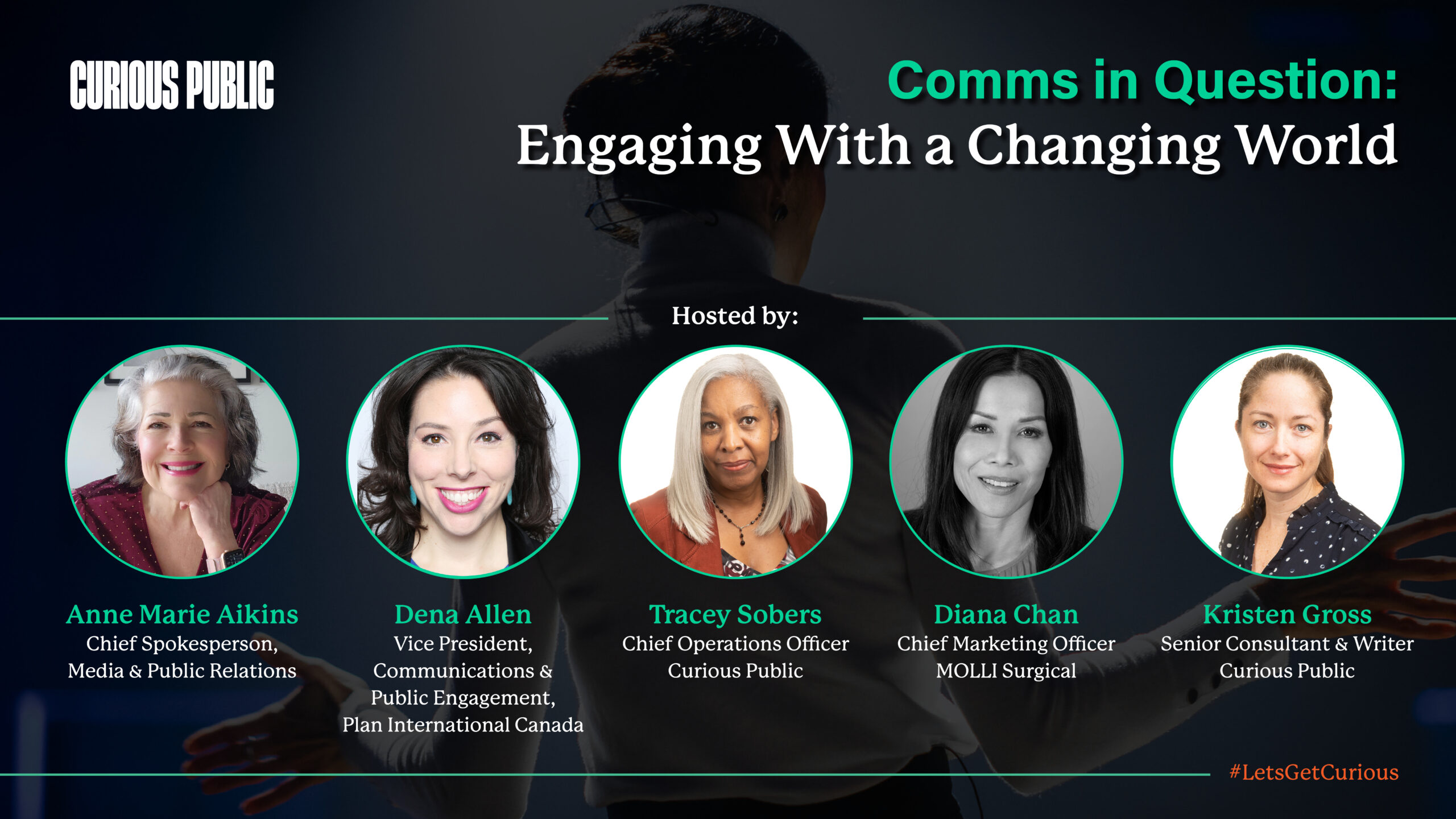Whose stories are you telling? And are you telling them ethically?
That was the first of many challenging questions posed to our panel of comms experts by our Chief Operations Officer, Tracey Sobers last week. The conversation was riveting and the insights the panelists shared were richly nuanced.
Their insights covered everything from ethical storytelling to trauma-informed communications, from handling shrinking budgets to leveraging ChatGPT. And I encourage any comms professional who wants to stay sharp and attuned to the demands of our industry to watch the recording.

Our panelists insights’ on the best practices for more ethical storytelling were just the tip of the iceberg. But an appropriate start given the backdrop of International Women’s Day (IWD).
IWD always sparks provocative conversations that expand our evolving understanding of feminism, alliship, and how we can further advance human rights for all people. And aligning with the ethical storytelling movement plays a critical role in how communications are developed and executed in 2023.
Why Does Ethical Storytelling Matter?
Stories are currency. And we use them to advance our organizations’ goals, drive donations, change policies, or get more subscribers, likes and shares. But storytelling – particularly on behalf of another group – quickly runs the risk of exploitation versus amplification.
So, how are you and your team evolving your storytelling this year? Here are some best practices to keep in mind.
-
Invest in opportunities for people to tell their own stories
The call for ethical storytelling is an exciting shift happening in the social impact space, and Plan International Canada is meeting that call by investing resources differently. Dena Allen shared that Plan International made the conscious choice to pivot from telling its global partners’ stories to investing in ways to have partners tell their own stories as a means to combat the entrenched racial stereotyping that can occur in the social impact space.
“What’s really important – and what we’re moving towards – is ensuring that we’re not telling stories on behalf of people. We’re not telling stories for people. We’re getting out of the way,” says Allen.
Instead, Allen explains that Plan is putting its resources and attention towards creating platforms for local storytellers to create and share their own stories with the Plan audience.
The organization also applies that principle to how content and stories are collected. Instead of sending in foreign journalists and photographers, Plan invests in finding local writers, reporters, storytellers, photographers and working with local communities so they can produce the content of their stories. And Plan invests in diversifying its editing spaces to reduce biases and a colonialist lens.
-
Put attention to the language and timing of stories
The adjectives and nomenclature we use in our stories and the moments we choose to tell them have as much influence as the content itself, explains Diana Chan through her experience at MOLLI Surgical. The Canadian medical device company’s audience is women on a healthcare journey through breast cancer. Choosing words wisely to authentically engage with this audience is the EQ demand of Chan’s work. But she and her team meet that demand by listening carefully and sensitively to the community they serve.
Chan explains that very often the words traditionally used to describe breast cancer and people living with a diagnosis like, “brave,” “battling,” and “survivor” can oversimplify the experience and have a negative impact on people living with cancer when they feel they can’t meet those descriptions.
“They feel like they need to be brave,” Chan says, “they feel like they need to be positive when they’re just so scared they want to curl up in a ball and cry. So what are the words that are going to honour our audience in our ethical storytelling?”
Chan also notes that raising sensitivity to the timing of messages is key to honouring an audience. She cites that for MOLLI’s audience, navigating the spotlight of Breast Cancer Awareness Month (October) is challenging.
“Taking [timing] for granted when we’re doing our stories and messaging is missing the boat,” says Chan. “So for me and our team, it’s trying to find the balance of how we honour this community and at the same time use words and having timing that makes a difference for them.”
-
Creating safety for storytellers
Telling your story comes at a cost, Anne Marie Aikins points out. Through her communications and advocacy work in the Rape Crisis Movement, Aikins explains that to help people tell their stories, work had to be done with them ahead of time to create boundaries to ensure their safety.
“People would spontaneously tell stories,” says Aikins. “You’d walk away from them and not realize the chaos that would ensue in their own personal lives and the impact that it had on people.”
Aikins stresses the need for communications and media professionals to understand and help support storytellers through the full cycle of sharing their experiences – from preparing safe boundaries to checking up with subjects after they’ve told their stories.
“In today’s world – the social media world – they get harassed and abused and so forth. I think we’ve seen a lot of that with our female public figures, journalists, or politicians,” says Aikins.
Aikins calls on comms professionals, reporters, and other writers to incorporate trauma-informed communications practices into their work to safeguard subjects and the stories they share.
-
Respect and accessibility are in the specifics
Our job at Curious Public is to distill complex concepts into compelling stories that get people talking. Easier said than done when we’re helping organizations distill challenging subjects with deep social impact like understanding a cancer journey, bringing awareness to palliative care, or reporting on anti-Black racism. Kristen Gross explains that respect for subjects and subject matter while at the same time engaging an outside audience is achieved through the specifics of storytelling.
“One of the early pieces of advice that I received as a writer from one of my mentors is that the universal is in the specifics,” says Gross. “Using a specific story to tell a universal story somehow makes it that much more accessible to people. It makes it visceral, instead of intellectual. Makes it real rather than theoretical. And clear rather than vague.”
Gross explains that much of her success in connecting with audiences about large concepts comes by way of telling the specifics of one story – and getting the details of that story right.
“It’s really important that we do [tell someone’s story] in a way that’s welcoming, that’s accurate, that’s empowering,” says Gross, who also notes that consent is critical to this work. “The universal is in the specifics, but the specifics are very ripe places to be doing communications work.”
Our work in communications is political, because storytelling is political. Who is the centre of our stories, how they’re told, and who gets to tell them is the landscape we’ve inherited that is scarred by battle yet fertile for new growth.
So how will you seed it for the seasons ahead? Check out our full conversation for inspiration.
Thank you again to our panelists, Anne Marie Aikins, Dena Allen, Diana Chan, and Kristen Gross. And a special thanks to our wonderful host, Tracey Sobers.
Shannon Currie
Senior Consultant and Writer at Curious Public.
Related Posts
September 11, 2020
LRC UPLIFT:
Doing Our Little Bit of Good to Uplift And Build Our Communities
0 Comments3 Minutes


